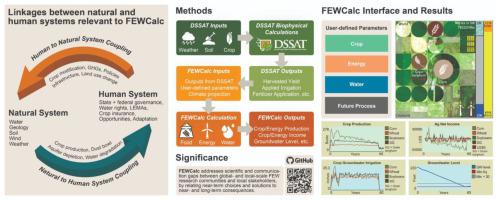Agricultural Systems ( IF 6.6 ) Pub Date : 2021-07-10 , DOI: 10.1016/j.agsy.2021.103222 Jirapat Phetheet 1 , Mary C. Hill 2 , Robert W. Barron 3 , Benjamin J. Gray 4 , Hongyu Wu 5 , Vincent Amanor-Boadu 6 , Wade Heger 7 , Isaya Kisekka 8 , Bill Golden 6 , Matthew W. Rossi 9

|
CONTEXT
The larger scale perspective of Integrated Assessment (IA) and smaller scale perspective of Impacts, Adaptation, and Vulnerability (IAV) need to be bridged to design long-term solutions to agricultural problems that threaten agricultural production, rural economic viability, and global food supplies. FEWCalc (Food-Energy-Water Calculator) is a new freeware, agent-based model with the novel ability to project farm incomes based on crop selection, irrigation practices, groundwater availability, renewable energy investment, and historical and projected environmental conditions. FEWCalc is used to analyze the interrelated food, energy, water, and climate systems of Finney County, Kansas to evaluate consequences of choices currently available to farmers and resource managers.
OBJECTIVE
This article aims to evaluate local farmer choices of crops and renewable energy investment in the face of water resource limitations and global climate change. Metrics of the analysis include agricultural and renewable-energy production, farm income, and water availability and quality. The intended audience includes farmers, resource managers, and scientists focusing on food, energy, and water systems.
METHODS
Data derived from publicly available sources are used to support user-specified FEWCalc input values. DSSAT (Decision Support System for Agrotechnology Transfer) with added arid-region dynamics is used to obtain simulated crop production and irrigation water demand for FEWCalc. Here, FEWCalc is used to simulate agricultural and energy production and farm income based on continuation of recent ranges of crop prices, farm expenses, and crop insurance; continuation of recent renewable-energy economics and government incentives; one of four climate scenarios, including General Circulation Model projections for Representative Concentration Pathway 8.5; and groundwater-supported irrigation and its limitations.
RESULTS AND CONCLUSIONS
A 50-year (2018-2067) climate and groundwater availability projection process indicates possible trends of future crop yield, water utility, and farm income. The simulation during more wet years produces high crop production and slower depletion of groundwater, as expected. However, surprisingly, the simulations suggest that only the Drier Future scenario is commercially profitable, and this is because of reduced expenses for dryland farming. Although simulated income losses due to low crop production are ameliorated by the energy sector income and crop insurance, the simulation under climate change still produces the worst annual total income.
SIGNIFICANCE
FEWCalc addresses scientific, communication, and educational gaps between global- and local-scale FEW research communities and local stakeholders, affected by food, energy, water systems and their interactions by relating near-term choices to near- and long-term consequences. This analysis is needed to craft a more advantageous future.
中文翻译:

使用两个免费软件程序 FEWCalc 和 DSSAT 将农业、能源和水资源决策与农场收入和气候预测相关联
语境
需要将综合评估 (IA) 的大尺度视角与影响、适应和脆弱性 (IAV) 的小尺度视角结合起来,以设计对威胁农业生产、农村经济可行性和全球粮食供应的农业问题的长期解决方案. FEWCalc(食物-能量-水计算器)是一种新的免费软件、基于代理的模型,具有根据作物选择、灌溉实践、地下水可用性、可再生能源投资以及历史和预测环境条件来预测农场收入的新颖能力。FEWCalc 用于分析堪萨斯州芬尼县相互关联的食物、能源、水和气候系统,以评估农民和资源管理者当前可用选择的后果。
客观的
本文旨在评估当地农民面对水资源限制和全球气候变化对农作物和可再生能源投资的选择。分析指标包括农业和可再生能源生产、农场收入以及水的可用性和质量。目标受众包括农民、资源管理者和关注食物、能源和水系统的科学家。
方法
来自公开来源的数据用于支持用户指定的 FEWCalc 输入值。DSSAT(农业技术转让决策支持系统)增加了干旱地区动态,用于获得 FEWCalc 的模拟作物生产和灌溉用水需求。在这里,FEWCalc 用于根据近期作物价格、农场费用和作物保险的持续范围来模拟农业和能源生产以及农场收入;延续最近的可再生能源经济和政府激励措施;四种气候情景之一,包括代表性浓度路径 8.5 的一般循环模型预测;和地下水支持的灌溉及其局限性。
结果和结论
50 年(2018-2067 年)气候和地下水可用性预测过程表明未来作物产量、水资源利用和农业收入的可能趋势。正如预期的那样,在更潮湿的年份进行的模拟会产生较高的作物产量和较慢的地下水消耗。然而,令人惊讶的是,模拟结果表明,只有“未来干旱”情景具有商业利润,这是因为旱地农业的费用减少了。尽管能源部门收入和作物保险减少了由于作物产量低导致的模拟收入损失,但气候变化下的模拟仍然产生最差的年度总收入。
意义
FEWCalc 通过将近期选择与近期和长期后果联系起来,解决了受食品、能源、水系统及其相互作用影响的全球和地方规模的 FEW 研究社区与当地利益相关者之间的科学、交流和教育差距。需要这种分析来创造一个更有利的未来。



























 京公网安备 11010802027423号
京公网安备 11010802027423号